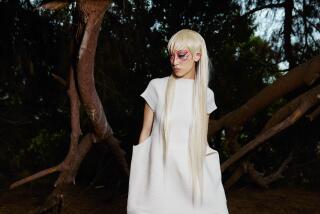AROUND HOME : The Art of Applique
- Share via
FOR MOST PEOPLE, quilting means patchwork--the careful fitting together of geometric pieces to form a whole. But applique, the “other” quilting technique, is almost as widespread; in some ways, applique is more fun because it allows the quilter greater freedom of expression.
Applique is a French word for an American craft: One piece of fabric is “applied” to another, with the edges of the top piece turned under and sewn down to the backing fabric with tiny, invisible hand stitches. Modern technology--zigzag machines, for instance--has allowed the overstitched edge, which gives a more informal look; purists still prefer old-fashioned hand-sewn applique.
Unlike patchwork, applique was not conceived in poverty; Colonial women with cloth to spare let loose their imaginations with applique and created some astonishing works of art. Many antique applique quilts have survived, perhaps because they were considered more special than patchwork--and not used as often.
A patchwork quilt top is a single layer of fabric with several seams, but applique can be two or more layers thick (for instance, the petals of a rose). With applique, a quilter can make circles, curves and even free-form amoeba shapes that are almost impossible to fashion in patchwork. Floral designs made with plain-colored fabrics are most commonly used in traditional applique patterns: The flowers can be “shaded” by adding pieces of different-colored fabric, with the leaves and stems extended to the edge of the patch or looped around the entire quilt. Other popular applique patterns include the Gordion knot and many variations on oak leaves and feathers.
Some patterns combine patchwork and applique--Dresden plate, sunflower, sunbonnet Sue--but by far the most spectacular use of applique is the Hawaiian quilt, usually one large piece of colored fabric cut into amazingly intricate shapes, not unlike large paper cutouts, and placed on a pale background. Some of these are feathery, like snowflakes, and some are as saturated with color as an Amish quilt.
Quilting materials, books and classes are available at McGuire’s Quilt and Needlework in Santa Monica; Material Pleasures in Arcadia; O’Gar’s Yardage in South Pasadena; Stitch ‘N Yarn in Glendale (no classes); Quilt ‘n’ Things in Montrose; Quilt Sails in San Pedro; Quilts Unlimited in Torrance; Piecemakers Country Store in Costa Mesa; Quilt Emporium in Calabasas, and The Quilt Inn in Thousand Oaks.
“Super Quilter II,” by Carla J. Hassel (published in 1982 by Wallace-Homestead Book Co., a division of Chilton Book Co., Radnor, Pa. (800) 638-3822) has two good chapters on applique, and many patchwork books also include applique patterns. “Hawaiian Quilting Made Easy,” by Milly Singletary, is available from Sunset Publications, 2650 W. Union Hills Drive, Phoenix, Ariz. 85027 for $4.95 plus $1 shipping.


